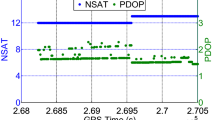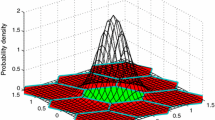Abstract
Reliable integer ambiguity resolution (IAR) is essential for carrier phase-based centimeter-level accurate positioning using global navigation satellite systems (GNSSs). In all IAR methods, the best integer equivariant (BIE) estimator is optimal in the sense of minimizing the mean-squared errors. However, the BIE estimator comprises an enumeration in the integer space of ambiguities, and its complexity grows exponentially with the number of ambiguities. Moreover, in a complex urban environment, the positioning performance of the BIE estimator is also reduced due to larger observation errors and even outliers. To address this problem, an efficient and reliable IAR method is proposed in this paper, which consists of two major steps. First, we apply the vectorial integer bootstrapping (VIB) (Teunissen et al. in J Geod 95(9):1–14, 2021) by implementing BIE in each sequential block-by-block integer estimation to improve computation efficiency, which is denoted as VIB-BIE. Second, a measure, named the acceptable probability (ACP), is defined to control the reliability of VIB-BIE estimation. Both simulated and real multi-GNSS data are employed to evaluate the performance of the proposed method and conventional BIE. The results show that the flexibility and efficiency of IAR are both improved by VIB-BIE. In a complex urban environment, the ACP-based VIB-BIE outperforms the BIE in terms of IAR reliability and positioning accuracy. Compared to the BIE, the positioning accuracies are improved by 42.4%, 34.2%, and 31.8% in the east, north, and upward directions, respectively.











Similar content being viewed by others
Data availability
The datasets used in the study are available from the corresponding author upon reasonable request.
References
Banville S (2016) GLONASS ionosphere-free ambiguity resolution for precise point positioning. J Geod 90(5):487–496
Brack A, Henkel P, Gunther C (2014) Sequential best integer-equivariant estimation for GNSS. Navigation 61(2):149–215
Duong V, Harima K, Choy S, Rizos C (2021) GNSS best integer equivariant estimation using multivariant t-distribution: a case study for precise point positioning. J Geod 95(1):1–17
Euler HJ, Schaffrin B (1991) On a measure for the discernibility between different ambiguity solutions in the static-kinematic GPS-mode. Kinemat Syst Geod Survey Remote Sens 107:285–295
Han S (1997) Quality control issues relating to instantaneous ambiguity resolution for real-time GPS kinematic positioning. J Geod 71(6):351–361
Li B, Li Z, Zhang Z, Tan Y (2017) ERTK: extra-wide-lane RTK of triple-frequency GNSS signals. J Geod 91(9):1031–1047
Li B, Shen Y, Feng Y, Gao W, Yang L (2014) GNSS ambiguity resolution with controllable failure rate for long baseline network RTK. J Geod 88(2):99–112
Li B, Miao W, Chen G, Li Z (2022) Ambiguity resolution for smartphone GNSS precise positioning: effect factors and performance. J Geod 96(9):1–18
Ma L, Lou Y, Lu L, Liu W, Zhu F (2022) GNSS best integer equivariant estimation combining with integer least squares estimation: an integrated ambiguity resolution method with optimal integer aperture test. GPS Solut 26(4):100
Miao W, Li B, Gao Y (2023) The superiority of multi-GNSS L5/E5a/B2a frequency signals in smartphones: stochastic modeling, ambiguity resolution and RTK positioning. IEEE Internet Things 10(8):7315–7326
Odolinski R, Teunissen PJG (2020) Best integer equivariant estimation: Performance analysis using real data collected by low-cost, single-and dual-frequency, multi-GNSS receivers for short-to long-baseline RTK positioning. J Geod 94(9):1–17
Odolinski R, Teunissen PJG (2022) Best integer equivariant position estimation for multi-GNSS RTK: a multivariate normal and t-distributed performance comparison. J Geod 96(1):1–14
Teunissen PJG (1993) Least-squares estimation of the integer GPS ambiguities. In: Invited lecture, section IV theory and methodology, IAG general meeting, Beijing, China, pp 1–16
Teunissen PJG (1995) The least squares ambiguity decorrelation adjustment: a method for fast GPS integer estimation. J Geod 70:65–82
Teunissen PJG (1998) Success probability of integer GPS ambiguity rounding and bootstrapping. J Geod 72(10):606–612
Teunissen PJG (1999) An optimality property of the integer least-squares estimator. J Geod 73(11):587–593
Teunissen PJG (2003a) Integer aperture GNSS ambiguity resolution. Artif Satell 38(3):79–88
Teunissen PJG (2003b) Theory of integer equivariant estimation with application to GNSS. J Geod 77(7):402–410
Teunissen PJG (2005) On the computation of the best integer equivariant estimator. Artif Satell 40(3):161–171
Teunissen PJG (2007) Influence of ambiguity precision on the success rate of GNSS integer ambiguity bootstrapping. J Geod 81(5):351–358
Teunissen PJG (2020) Best integer equivariant estimation for elliptically contoured distributions. J Geod 94(9):1–10
Teunissen PJG, Massarweh L, Verhagen S (2021) Vectorial integer bootstrapping: flexible integer estimation with application to GNSS. J Geod 95(9):1–14
Tiberius CCJM, De Jonge PJ (1995) Fast positioning using the LAMBDA method. In: Proceedings DSNS-95, paper, vol 30, No. 8
Verhagen S (2005) The GNSS integer ambiguities: estimation and validation. Ph.d. dissertation, Netherlands Geodetic Commission, Publications on Geodesy, 58
Verhagen S, Teunissen PJG (2005) Performance comparison of the BIE estimator with the float and fixed GNSS ambiguity estimators. A Window on the Future of Geodesy, International Association of Geodesy Symposia, vol 128. Springer, Berlin, Heidelberg, pp 428–433
Verhagen S, Li B, Teunissen PJG (2012) LAMBDA—Matlab implementation, version 3.0. Delft University of Technology and Curtin University
Verhagen S, Li B, Teunissen PJG (2013) Ps-LAMBDA: ambiguity success rate evaluation software for interferometric applications. Comput Geosci 54:361–376
Vollath U, Talbot NC (2013) GNSS signal processing methods and apparatus with candidate set selection. US Patent 008368590B2
Wang J, Stewart M, Tsakiri M (1998) A discrimination test procedure for ambiguity resolution on-the-fly. J Geod 72(11):644–653
Wu Z (2022) GNSS integer ambiguity posterior probability calculation with controllable accuracy. J Geod 96(8):1–16
Yu X, Wang J, Gao W (2017) An alternative approach to calculate the posterior probability of GNSS integer ambiguity resolution. J Geod 91(3):295–305
Zhang W, Wang J (2024) GNSS PPP-RTK: integrity monitoring method considering wrong ambiguity fixing. GPS Solut 28:30
Zhang Z, Li Y, He X, Chen W, Li B (2022) A composite stochastic model considering the terrain topography for real-time GNSS monitoring in canyon environments. J Geod 96(10):1–19
Zhang W, Wang J, El-Mowafy A, Rizos C (2023a) Integrity monitoring scheme for undifferenced and uncombined multi-frequency multi-constellation PPP-RTK. GPS Solut 27(2):68
Zhang W, Wang J (2023b) Integrity monitoring scheme for single-epoch GNSS PPP-RTK positioning. Satell Navig 4(10)
Zhang Z, Yuan H, He X, Li B, Geng J (2023c) Best integer equivariant estimation with quality control in GNSS RTK for canyon environments. IEEE Trans Aerosp Electr Syst 1:14. https://doi.org/10.1109/TAES.2023.3236916
Acknowledgements
This work is supported by the National Natural Science Foundations of China (42225401, 42074026), the Innovation Program of Shanghai Municipal Education Commission (2021-01-07-00-07-E00095) and the Scientific and Technological Innovation Plan from Shanghai Science and Technology Committee (22511103003).
Author information
Authors and Affiliations
Contributions
WM proposed the idea, designed and conducted the numerical experiments, analyzed the data and wrote the manuscript. WM, BL, GC developed the theory and algorithms. BL and YG supervised the project and revised the manuscript. All authors joined discussions throughout the development.
Corresponding author
Rights and permissions
Springer Nature or its licensor (e.g. a society or other partner) holds exclusive rights to this article under a publishing agreement with the author(s) or other rightsholder(s); author self-archiving of the accepted manuscript version of this article is solely governed by the terms of such publishing agreement and applicable law.
About this article
Cite this article
Miao, W., Li, B., Gao, Y. et al. Vectorial integer bootstrapping of best integer equivariant estimation (VIB-BIE) for efficient and reliable GNSS ambiguity resolution. J Geod 98, 30 (2024). https://doi.org/10.1007/s00190-024-01836-3
Received:
Accepted:
Published:
DOI: https://doi.org/10.1007/s00190-024-01836-3




